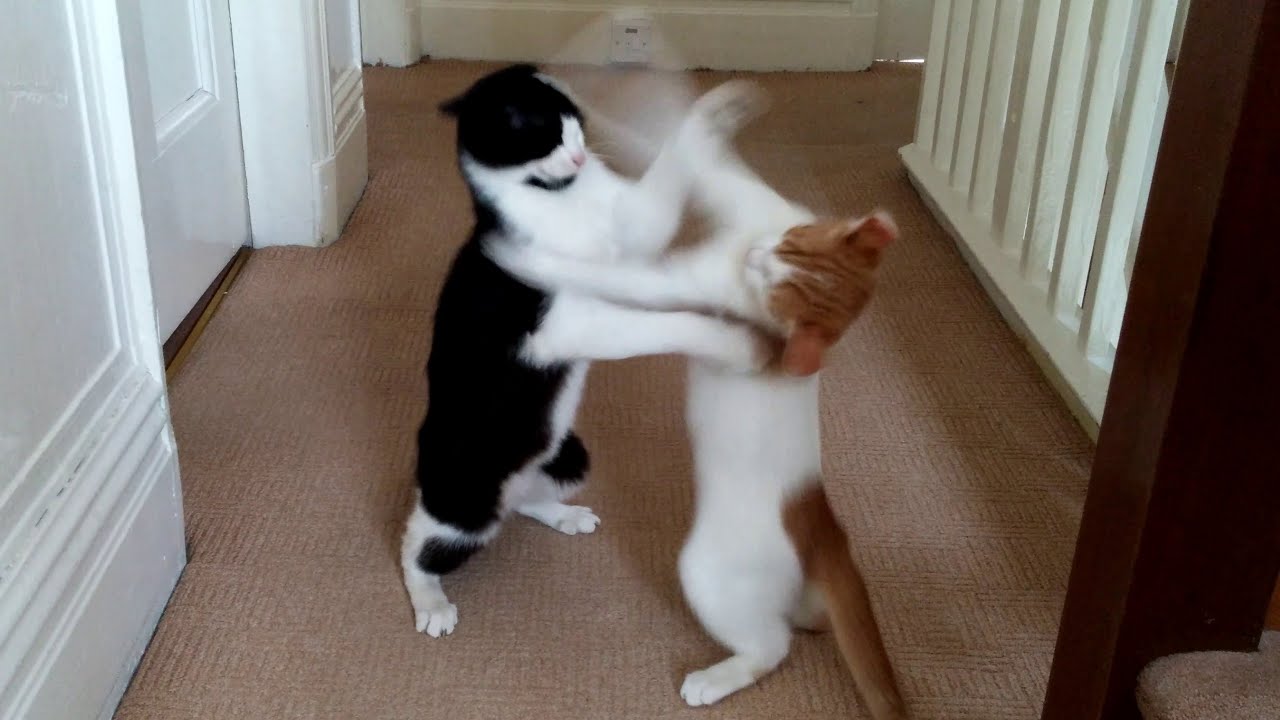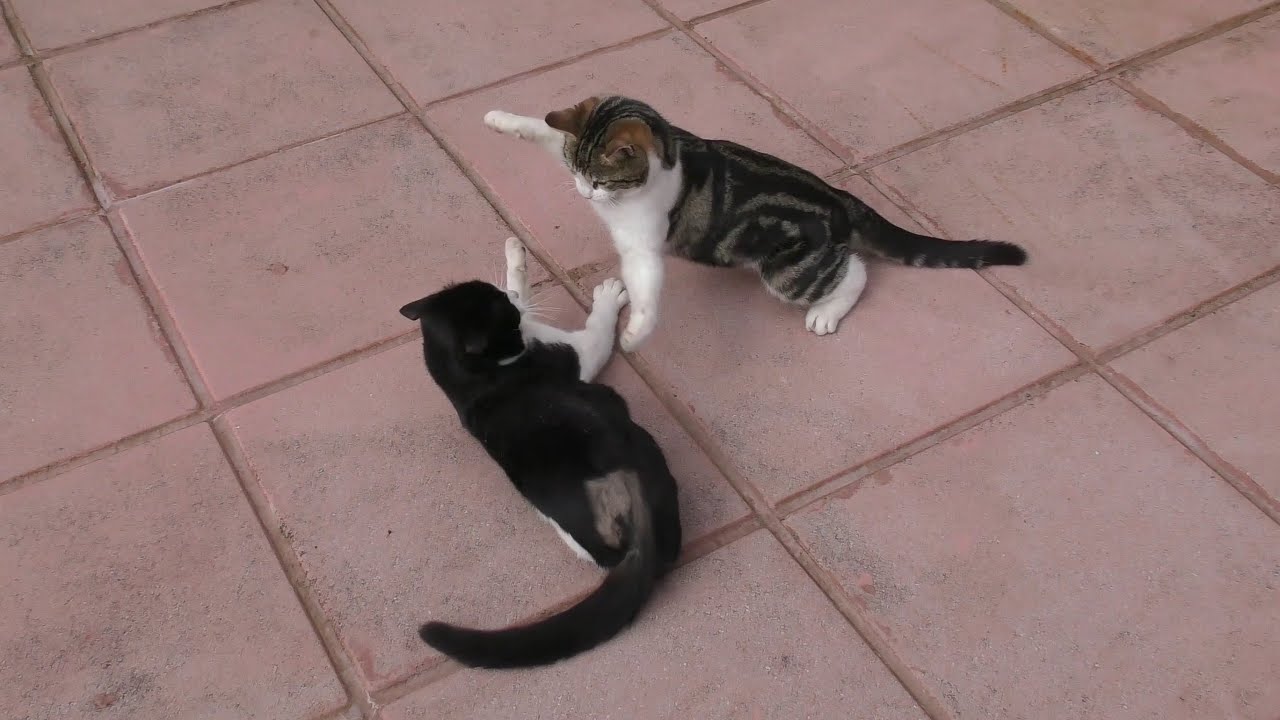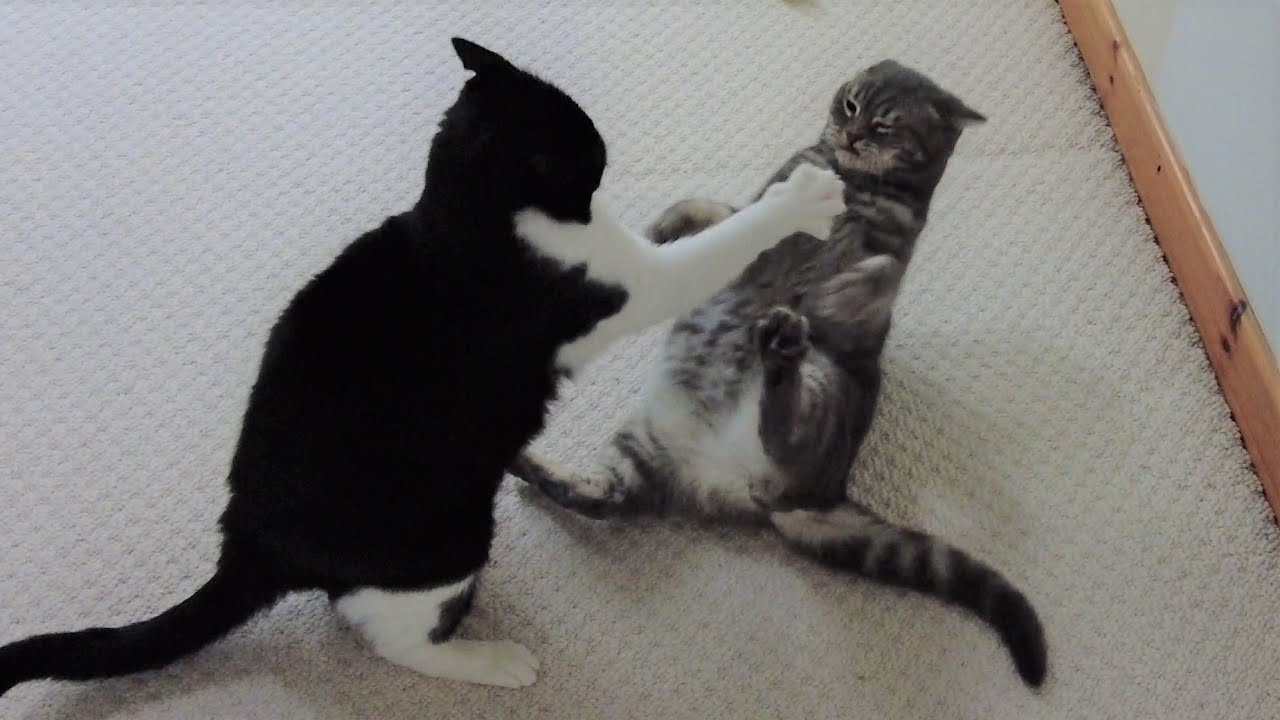Understanding cats play fighting is essential for any cat owner. It’s not just a wild romp around the house; play fighting is a vital form of communication and skill development among our feline friends. This article dives deep into the significance of play fighting, explores its nuances, and provides expert tips to help owners support their playful kitties.
Understanding Cats Play Fighting: A Form of Feline Communication
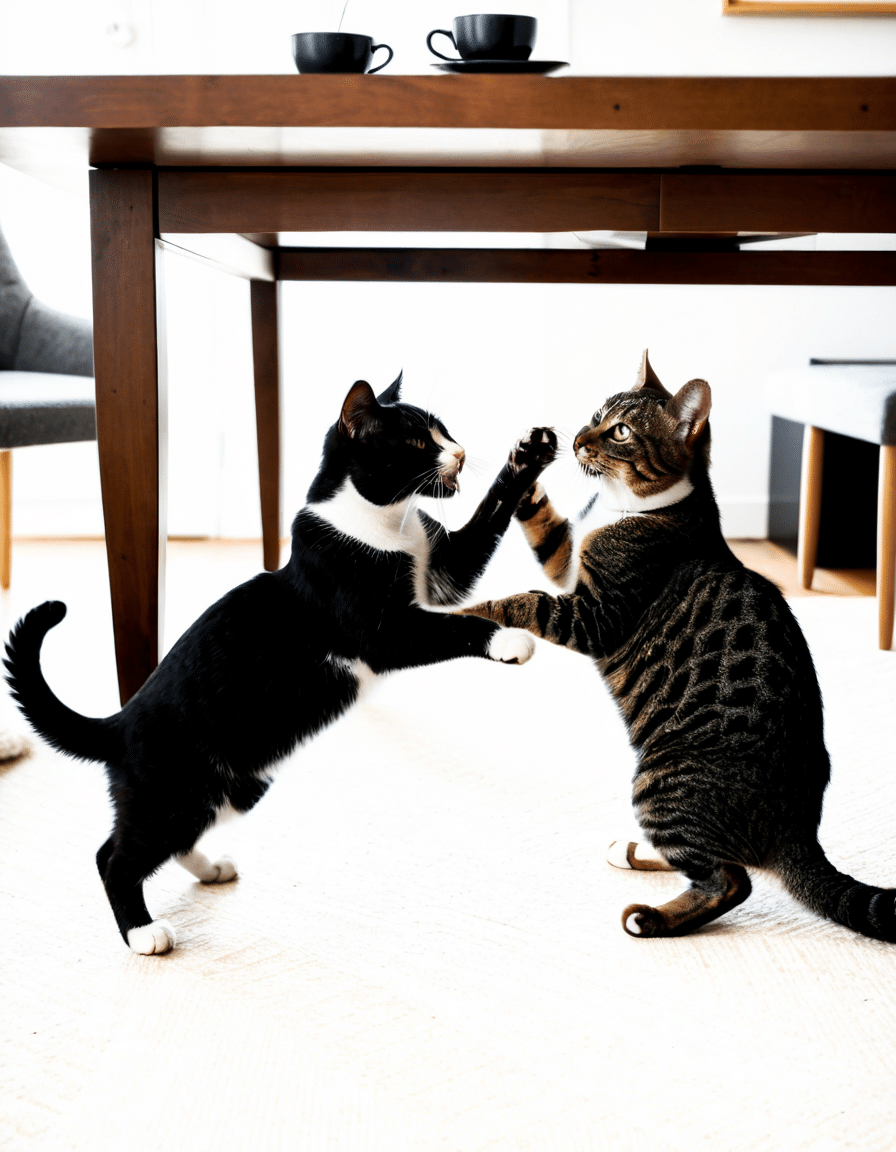
1. The Importance of Play for Cats: Beyond Fun and Games
Every cat owner knows that cats seem to possess boundless energy, but did you know that play serves a much deeper purpose? Play is essential for cats’ mental and physical health. It helps them hone critical skills that they’d use in hunting and social interactions, all while avoiding the risks of real confrontations. According to research from the University of Bristol, engaging in play boosts confidence and aids in social development, especially for kittens, by giving them the chance to practice their hunting techniques without any real-world dangers.
Engaging in cats play fighting helps to foster crucial connections between cats and their environment. Through these play sessions, cats learn not only about their ability to stalk and pounce but also about their interactions with other animals. This playful behavior is their way of establishing boundaries, learning cooperation, and developing social hierarchies.
So, while it might look like chaos, it’s a wonderfully dynamic arena where cats learn about themselves and the world around them!
2. 7 Secrets of Cats Play Fighting Every Owner Should Know
2.1 Recognizing Safe Play Fighting vs. Aggression
Understanding the difference between cat play fighting and aggression is crucial. Subtle signs can often indicate whether your cat is having a great time or feeling threatened. Play fighting includes behaviors like gentle biting, pouncing, and playful swats. On the flip side, aggression looks much different and often includes hissing, growling, or a stiff posture.
Learning these signs can help owners manage their cats’ interactions with other animals or even with people. Cats will often have a built-in way of communicating their feelings through body language, and it’s our job to tune in to these messages.
2.2 The Role of Socialization in Play Fighting
Socialization is key to healthy play interactions. A cat’s early experiences can significantly influence how they play later in life. If a kitten isn’t socialized properly, it may become overly aggressive during playful moments with other cats or people.
Studies conducted by the American Association of Feline Practitioners highlight that exposing kittens to various play experiences—like interacting with different toys and environments—helps develop their social skills. It can even reduce the likelihood of aggressive behavior later on.
2.3 Equipment and Environment: Setting the Stage for Safe Play
The right environment can act as a catalyst for safe and enriching play. Consider introducing toys that promote chasing and hunting instincts without the risks that come from real-life engagements. Feather wands and laser pointers can serve as excellent tools for encouraging healthy play sessions.
Further, incorporating scratching posts and climbing trees into your home can provide your cat with a way to channel their energy into playful antics. Each piece of equipment can enhance your cat’s play experience and supports their natural instincts, making the play session both safe and fun.
2.4 Understanding Breed Differences in Play Fighting
Believe it or not, the way cats play can vary significantly by breed. For instance, Bengals are known for their high energy levels and may engage in highly vigorous play sessions that can leave you both astounded and entertained. On the other hand, more laid-back breeds like Persians typically prefer a more sedate, gentle form of play.
Understanding these differences allows owners to tailor their cats’ play experiences to match their personality and energy levels. It’s all about finding what suits your cat’s unique play style, so they receive the best mental stimulation.
2.5 To Supervise or Not? The Debate on Intervention
Play fighting can get a bit intense at times, and it can be tempting for owners to intervene. But knowing when and how to do so is key. If play escalates into true aggression, it’s time to step in. Certified cat behaviorist Jackson Galaxy recommends using distractions instead of physically separating the cats, as this won’t cause injury to either party.
Understanding the flow of play helps keep your cats safe and happy. Over time, you’ll learn to judge when to let them be and when a gentle intervention is necessary.
2.6 Signals That Indicate Play Time is Over
Cats, like people, have their limits, and it’s crucial to recognize when a play session needs to wrap up. Typical signals include flattened ears, twitching tails, or a sudden retreat. Recognizing these signs ensures that both cats remain comfortable and engaged without overstepping boundaries.
It’s vital to keep an eye out for these tips to respect your cat’s comfort zone during playtime. Respect for their limits fosters trust and a stronger bond.
2.7 Creating Structured Play Opportunities
To ensure that cats receive optimal physical and mental stimulation, consider incorporating structured play opportunities into their daily routine. Scheduling daily play sessions helps create consistency, allowing your cats to know what to expect and when to expect it.
Moreover, utilizing interactive toys like the PetSafe Bolt Interactive Laser Cat Toy can mimic the thrill of play fighting, helping them channel their energy in positive ways. Cats enjoy the mental challenge, and structured playtime can lead to a well-exercised and happy feline.
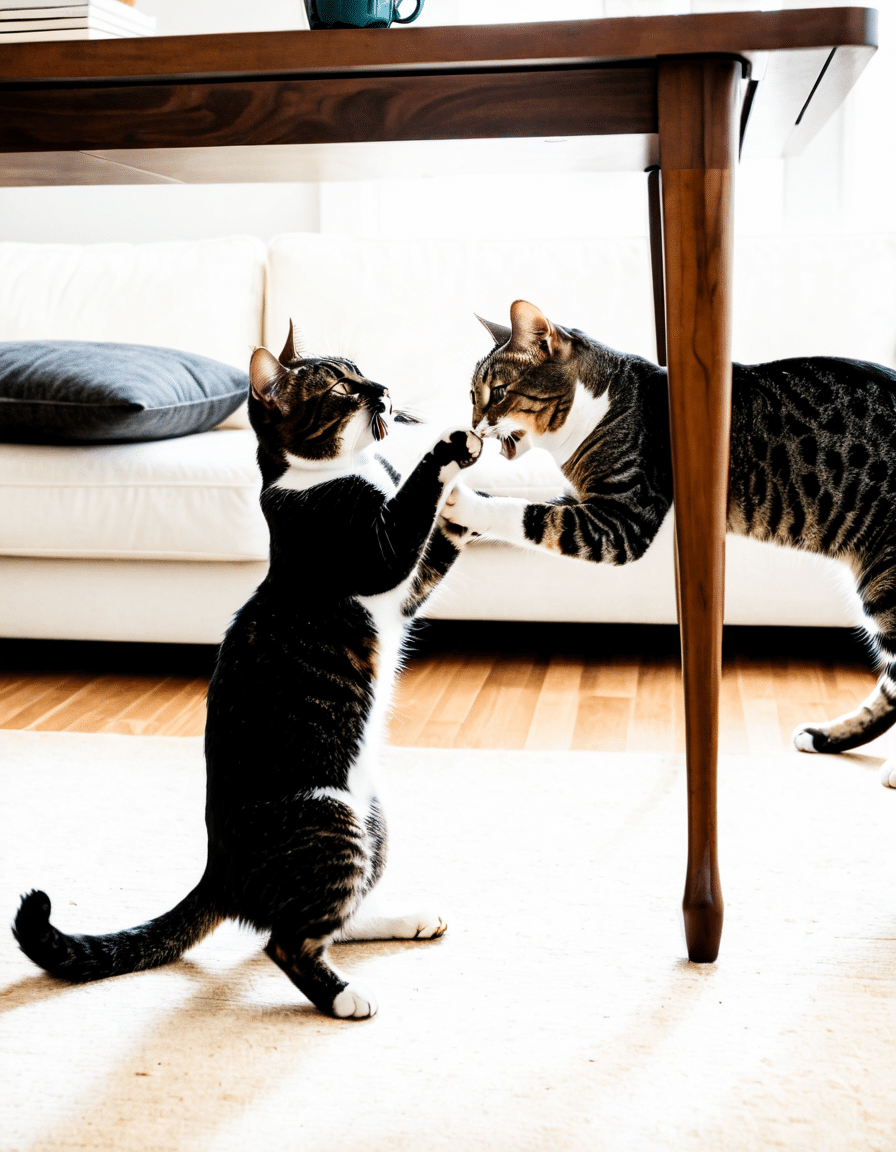
Embracing Cats Play Fighting: A Pathway to Healthier Relationships
Understanding cats play fighting goes deeper than simple entertainment; it reveals insights into their behaviors, personalities, and needs. By recognizing safe play, creating an enriched environment, and appreciating each cat’s play style, owners can cultivate healthy and playful relationships that support overall wellbeing.
Ultimately, it’s about nurturing happy, confident cats who thrive on healthy interactions! So, the next time you witness your feline engaged in a playful wrestle, remember, you’re not just observing a fight; you’re witnessing communication and emotional growth in action.
By embracing the wonderful dynamics of cats play fighting, you’ll foster not only joy but also a deeper bond with your furry companions. Check out how cats play fighting can unlock a world of understanding and happiness in your household.
With a bit of knowledge and a lot of love, every cat owner can turn those playful tussles into moments of connection that strengthen the human-feline bond.
Cats Play Fighting Secrets Every Owner Should Know
Understanding the Battle of Wits
Did you know that cats play fighting is actually their way of honing essential life skills? Kittens often engage in this playful sparring with siblings to practice their hunting and survival techniques. It’s a natural behavior that shows off their predatory instincts! This playful banter can also help improve their agility and timing, much like how a thoroughbred horse develops its abilities over the living age Of race Horses.
What’s particularly fascinating is that not all cats are created equal in their play-fighting tendencies. For instance, a Maltese And Chihuahua mix may have more of a gentle demeanor, leaving heavy play fighting to the more robust breeds. Knowing your pet’s play style can help enrich their experience, ensuring they engage without either party getting hurt.
The Psychology Behind Play Fighting
Engaging in cats play fighting isn’t just physical; there’s a psychological component too. When cats wrestle, they create a social bond, helping to establish hierarchy and companionship amongst themselves. This interaction can be similar to how some Movies With Noomi rapace explore complex relationships, where characters engage in conflicts that ultimately strengthen their ties.
Interestingly, experts note that if a cat’s play fighting turns aggressive, it’s crucial to step in. Just like a teacher Onlyfans crisis, proper boundaries play a pivotal role. If left unchecked, play can escalate into dangerous territory, leading to stress or potential injuries. So, keep an eye on the fun!
Signs of Enjoyment vs. Distress
Recognizing the difference between happy play and distress signals is key as well. When your cats are enjoying themselves, their tails may be held high, and their bodies appear relaxed. On the flip side, telltale signs of stress include flattened ears and hissing. If you’re wondering how to tell if a stray cat gave birth, keep an eye out for these emotions, as the same signs apply. After all, a content cat will often feel secure enough to let its guard down, unlike someone in The terminal dealing with anxiety.
So, enjoy the antics of your playful feline friends! Revel in their spirited tussles and quirky movements, just be aware of the boundaries to keep their little skirmishes safe and entertaining. With these insights into cats play fighting, you’ll be better equipped to foster a healthy playtime atmosphere. Good night cat, and good luck with understanding their playful adventures!

Is it OK for cats to play fight?
It’s generally okay for cats to play fight, as long as it’s all in fun and neither cat is getting hurt. Play fighting helps them hone their hunting skills and socialize with each other. Just watch for any signs of distress, and step in if things get too rough.
What is the 3 3 3 rule for cats?
The 3 3 3 rule for cats involves three days, three weeks, and three months, which outlines a typical timeline for a cat to adjust to a new environment. After about three days, they might start to feel safe, three weeks is usually when they settle into their surroundings, and three months is when they typically feel at home.
How do I tell if my cat is playing or fighting?
You can tell if a cat’s playing or fighting by observing their body language. Playful cats often have relaxed bodies, upright tails, and their ears pointed forward, whereas fighting cats may look tense, their ears flattened, and their postures might be more aggressive.
Is it normal for cats to bite when play fighting?
It’s normal for cats to bite during play fighting, as they use their mouths to mimic hunting behaviors. These bites are usually gentle, and cats often do it to express excitement and not aggression.
Are cats happy when they play fights?
Yes, cats can be happy when they play fight, as it’s a way for them to express themselves and bond with each other. As long as the play is balanced and both cats are enjoying it, it’s a normal and healthy activity.
How to tell if cats are bonded?
You can tell if cats are bonded by observing their interactions; bonded cats often groom each other, sleep close together, and play nicely. They also may exhibit signs of comfort around each other, like purring and relaxed postures.
What is the golden rule of cats?
The golden rule of cats is that they should always have a safe space to retreat to when they feel overwhelmed. Respecting their boundaries helps build trust and a good relationship.
How long does it take a cat to bond with you?
Bonding with a cat can take time, often several weeks to a few months, depending on the cat’s personality and previous experiences. Patience and gentle interactions go a long way in creating a strong bond.
How old is 11 years old in cat years?
An 11-year-old cat is about 60 in cat years, which is considered a senior age. As they age, they may need adjusted care and attention to ensure their health and happiness.
Do bonded pair cats fight?
Bonded pairs of cats can still engage in some playful fighting, but they usually have a good sense of each other’s boundaries. If the play gets too rough, they may settle down and groom each other as a way to reaffirm their bond.
How to discipline a cat?
To discipline a cat, it’s best to use gentle methods like redirecting their behavior or using positive reinforcement. Yelling or physical punishment can frighten them and damage your relationship.
Why do cats show their belly when fighting?
Cats sometimes show their belly when play fighting as a way to demonstrate trust, but it can also serve as bait to engage their opponents. Keep in mind that not every cat enjoys belly rubs, so approach with caution.
Why does my cat grab my hand and bite me gently?
When your cat grabs your hand and bites gently, it’s often a sign of affection or playful behavior. They might just be trying to initiate play or express their love, but make sure to redirect them to toys if it becomes too much.
What are the best calming treats for cats?
The best calming treats for cats usually include natural ingredients like chamomile or valerian root. Look for ones that are specifically formulated to help with anxiety and have positive reviews from other cat owners.
What does it mean when a cat licks you?
Letting your cat play fight can be beneficial, provided it stays friendly. Just make sure to supervise their interactions and intervene if it looks like one cat is not enjoying it.
Should I let my cat play fight?
Play fighting usually doesn’t hurt cats, as it’s a natural part of their behavior. However, if one cat seems overly aggressive or scared, it’s important to step in and prevent any actual harm.
Does play fighting hurt cats?
It’s totally normal for cats to engage in play fighting, as it’s a way for them to express natural instincts and have fun. Just make sure to keep that playtime safe and monitor for any signs of distress.

